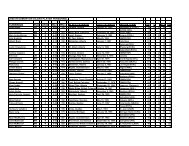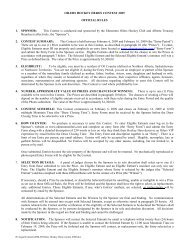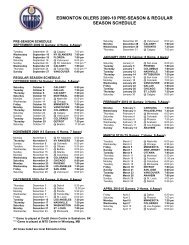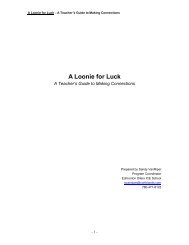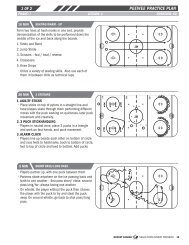Create successful ePaper yourself
Turn your PDF publications into a flip-book with our unique Google optimized e-Paper software.
NHL HOW TO FIGURE<br />
** NOTE: No individual skater/goaltender statistics apply for the shootout<br />
Assist An assist is awarded to the player or players (maximum of two) who touched the puck prior<br />
to the goal, provided no defender plays or possesses the puck in between.<br />
Game Played A player receives credit for playing in a game if: i) he steps on the ice during time played<br />
or; ii) serves any penalty.<br />
Game-Winning Goal After the final score has been determined, the goal which leaves the winning Club one goal<br />
ahead of its opponent is the game-winning goal (example: if Team A beats Team B 8-3, the<br />
player scoring the fourth goal for Team A receives credit for the game-winning goal).<br />
Goal A goal is awarded to the last player on the scoring Club to touch the puck prior to the puck<br />
entering the net.<br />
Goals-Against Average Multiply goals allowed (GA) by 60 and divide by minutes played (MINS).<br />
Goaltender A goaltender receives a “W” for a win in regulation, overtime or shootout; an “L” for a loss<br />
in regulation; or an “OT” for a loss in overtime or shootout.<br />
Penalty-Killing Pct. Subtract total number of power-play goals allowed from total number of shorthanded<br />
situations to get total number of power-plays killed. Divide the total number of powerplays<br />
killed by the total number of shorthanded situations.<br />
Plus-Minus A player receives a “plus” if he is on the ice when his Club scores an even-strength or<br />
shorthand goal. He receives a “minus” if he is on the ice for an even-strength or shorthand<br />
goal scored by the opposing Club. The difference in these numbers is considered the<br />
player’s plus-minus statistic.<br />
Power-Play Goal A goal scored by a Club while it has a manpower advantage due to an opponent’s penalty.<br />
Following are some examples of what is and is not considered a power-play goal:<br />
• if a Club has an advantage on a minor penalty starting at 2:02 of the period and it<br />
scores at 4:02, the goal is not a power-play goal.<br />
• if a Club scores on a delayed penalty, the goal is not a power-play goal.<br />
• if a Club has an advantage due to a five-minute major or match penalty, that Club is<br />
always credited with having one more advantage than the number of power-play goals<br />
it scores during that advantage, because the penalty does not expire. A new advantage<br />
begins after each power-play goal. For example, if Team A scores three goals during a<br />
major penalty, it is credited with four advantages.<br />
• if a Club is on a power-play for any length of time, it is considered to have had an<br />
advantage.<br />
• if a minor penalty is incurred by a Club on a power-play due to a major penalty, a new<br />
advantage is given to that Club when its minor penalty expires, provided the opponent’s<br />
major penalty is still in effect.<br />
Power-Play Percentage Total number of power-play goals divided by total number of power-play opportunities.<br />
Save Percentage Subtract goals allowed (GA) from shots against (SA) to determine saves. Then divide saves<br />
by shots-against.<br />
Shooting Percentage Divide the number of goals scored by the number of shots taken.<br />
Shorthand Goal A goal scored by a Club while it is at a manpower disadvantage. The same cases apply for<br />
shorthand as for power-play goals, but in the opposite manner.<br />
Shot on Goal If a player shoots the puck with the intention of scoring and if that shot would have gone in<br />
the net had the goaltender not stopped it, the shot is recorded as a “shot on goal”.<br />
Shutout If two goaltenders combine for a shutout, neither receives credit for the shutout. Instead it<br />
is recorded as a Club shutout.<br />
Tenths of a Second If a penalty or goal occurs in the last minute, the time is rounded off to the previous second<br />
(ex: if a penalty is called with 12.4 seconds left in a period, the time is indicated as 19:47<br />
and not 19:48.)<br />
Coaches Record A coach receives a “W” for a win in regulation, overtime or shootout; an “L” for a loss in<br />
regulation; or an “OT” for a loss in overtime or shootout.<br />
321



